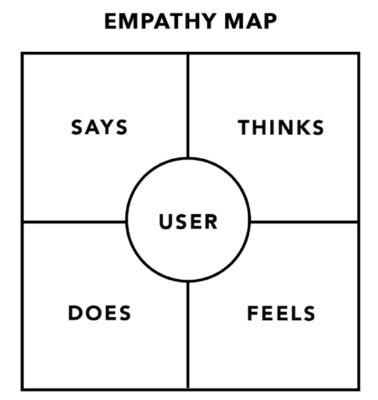We often see the B2B sales process as a cold analysis of the customer’s pain points, values, and goals. We forget that people buy business products. And whenever people are involved, we are dealing with feelings and emotions that drive purchase decisions. We are not as rational as we believe when it comes to making decisions (as Dan Ariely points out in the book “Predictably Irrational”).
Empathy helps build trust with your customers. It shows that your goal is not just to sell something, but to improve their lives. When creating your ideal customer profile, understand what your customers say, think, feel, and do to develop that empathy. Understanding what they say, think, feel, and do helps you figure out how to motivate them to act/make a purchase, break out of inertia and take action.
What is clear to me is that you cannot blindly trust what customers say. You need to hear how they feel, what they do, and how they think. Don’t wait for them to tell you the solution to your problems. Instead, pay attention to noticing subtle feelings and thoughts that paint a clearer picture of your day-to-day situation and activities. When we ask someone directly there is a filter and people tend to misrepresent and report when asked directly. In other words, often what we say and do are not in sync.
My journey to find a systematic approach to learning about customer feelings led me to discover the empathy map that UX/UI designers and researchers use to gather customer feedback. The most sophisticated product teams regularly show customers new features and product updates before launch and use an empathy map to rank their input. Startups can use this process to showcase and test product features before developing them.
However, customer development is not just for startups. Even established companies will benefit from showing and discussing product launches and features before committing large resources to build them. The customer development process never stops. Creating an ideal customer profile and conducting a customer discovery process are two sides of the same coin.
By driving customer development and gathering feedback, you refine your understanding of the ideal customer profile. At the same time, by researching your ideal customers, you can find better ideas and strategies to improve your product and drive customer development.
Here are some questions to help you get started with an empathy map:
- What are the customers thinking and feeling? What are some of your concerns and aspirations?
- What are your friends, colleagues, and leadership likely to say while the user is using our product? What would the customer hear in these scenarios?
- What would the user see when using our product in their environment?
- What might the user be saying and/or doing while using our product? How would that change in a public or private setting?
- What are some user pain points or fears when using our product?
- What gains can the user have when using our product?

Source: Empathy mapping helps you better understand your customers: nngroup.com
Your product and brand should strive to change how people feel about their responsibilities and themselves. Designing your solution to evoke feelings is a powerful way to connect with your customers. You first want to identify how your customers feel about their current broken or complicated process or unresolved issue. So you want to find out what they will feel after resolving these pains – including how they will feel afterward.

 Português
Português Português
Português
